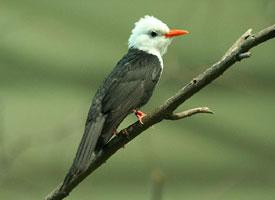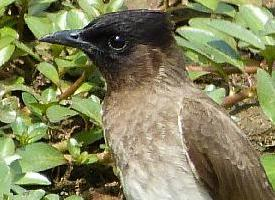
Cunoscut și ca
- Bulbulčík bělohlavý
Greutăți și măsuri
| Lungime | de la 24 la 25 cm |
|---|
Descrierea animalului
The Black Bulbul, scientifically known as Hypsipetes leucocephalus, is a distinctive and somewhat enigmatic bird species that belongs to the bulbul family, Pycnonotidae. This bird is known for its unique appearance and melodious song, which make it a fascinating subject of study for ornithologists and bird enthusiasts alike.Physically, the Black Bulbul is medium-sized, typically measuring between 24 to 25 centimeters in length. It has a predominantly glossy black plumage, which is where it gets its name from. However, its head is adorned with a striking white or light grey cap, creating a sharp contrast that is easily recognizable. The bird's bill is strong and slightly curved, allowing it to feed efficiently, and it varies in color from orange-red to deep red, adding a splash of vibrant color to its otherwise monochrome appearance.
One of the most interesting features of the Black Bulbul is its tail. Unlike many other birds, the tail of the Black Bulbul is distinctly forked, which not only aids in its aerial maneuvers but also contributes to its elegant appearance when perched or in flight. The bird's wings are broad and rounded, enabling it to navigate through its habitat with ease.
The Black Bulbul is native to a wide range of South and Southeast Asia, including the Himalayas, China, Taiwan, and parts of Indonesia. It inhabits a variety of forested environments, from the subtropical or tropical moist lowland forests to montane regions, showing a preference for areas with dense foliage and abundant food sources. It is quite adaptable and can also be found in secondary forests and plantations.
Diet-wise, the Black Bulbul is primarily frugivorous, feeding on a variety of fruits, berries, and occasionally seeds. However, it also includes insects in its diet, particularly during the breeding season, when the demand for protein is higher to support the growth of its young.
The social behavior of the Black Bulbul varies; it can be observed in pairs or small groups, and sometimes in larger flocks, especially when feeding. Its vocalizations are as distinctive as its appearance, characterized by a melodious and fluty song that can be heard across its habitat, particularly during the breeding season. This song plays a crucial role in territorial defense and in attracting mates.
Reproduction-wise, the Black Bulbul is monogamous, with pairs often remaining together for multiple breeding seasons. The nest, constructed by both sexes, is a simple yet sturdy cup made of twigs, leaves, and roots, placed in the fork of a tree or bush. The female typically lays two to three eggs per clutch, which are then incubated by both parents.
Despite facing threats from habitat destruction and fragmentation, the Black Bulbul has managed to maintain stable population levels in much of its range and is currently listed as Least Concern on the IUCN Red List. Its adaptability to altered landscapes has played a significant role in its resilience.
In summary, the Black Bulbul is a remarkable bird species, notable for its striking appearance, melodious song, and adaptable nature. Its presence adds vibrancy and life to the forest ecosystems of South and Southeast Asia, making it a cherished member of the region's avian biodiversity.
Animale similare
Fotografii noi cu animale
Top 10 animale
- Diana monkey (Cercopithecus diana)
- Dolphin gull (Leucophaeus scoresbii)
- Galápagos tortoise (Geochelone nigra complex)
- Moustached guenon (Cercopithecus cephus)
- Japanese spider crab (Macrocheira kaempferi)
- Colossal squid (Mesonychoteuthis hamiltoni)
- Fox tapeworm (Echinococcus multilocularis)
- Stone loach (Barbatula barbatula)
- Japanese macaque (Macaca fuscata)
- Barbary macaque (Macaca sylvanus)
